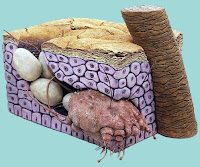This post is an overview of some of the main fungal or parasitic infections that could be seen in an athletic population. There are pictures to indicate the look of the infections in the event an athlete is suspected to have one.
Fungal: superficial fungal infections are the most common type for athletes. Tinea capitis (scalp), tinea barbae (beard area), tinea pedis (feet), tinea manum (hands), tinea cruris (groin area), tinea unguium (fingernails and toenails), and tinea corporis (skin area). Warm moist environment serves as the primary predisposing factor for all of these infections.
Fungal: superficial fungal infections are the most common type for athletes. Tinea capitis (scalp), tinea barbae (beard area), tinea pedis (feet), tinea manum (hands), tinea cruris (groin area), tinea unguium (fingernails and toenails), and tinea corporis (skin area). Warm moist environment serves as the primary predisposing factor for all of these infections.
·
Tinea Pedis (feet, athlete’s foot)
o
Most common: interdigital tinea pedis (web space
of toes = scaly, peeling)
o
Third hyperkeratotic scale on the plantar
surface of the foot.
§ All types, the patient will complain of itching,
especially after removing their socks
o
Treatment: mild
localized infections respond with topical antifungal powder (Tinactin). Moderate respond to topical creams
(Monistat) twice a day for 2-4 weeks. Extensive
cases may require oral antifungal medications (Lamisil) in addition to a
topical cream.
o
Prevention: wearing shower shoes in locker rooms
and shower areas. Keep feet dry with breathable socks and using tolnaftate
powder (Tinactin).
·
Tinea Corporis (ringworm)
o
Highly prevalent in wrestlers, also referred to
tinea gladiatorum
o
Presents with a circular, erythematous, pruritic
(itchy) plaque, with a raised edge, scaling, and central clearing.
o
Early lesions can look like dermatitis and later
lesions look like psoriasis or eczema.
o
It is spread through skin-to-skin contact and
occurs more often on the head, neck, and arms.
o
Treatment: athletes should be treated with antifungal
medications for at least 2-4 weeks whereas the normal population may only need
1-2 weeks. Topical treatments such as clotimazole (Lortimin) are effective for
noninflammatory cases.
o
NCAA rules state that an athlete presenting with
tinea corporis are to be withheld from practice for a minimum of 72 hours of
topical antifungal treatments. When the athlete returns, the lesion must be
covered.
o
Pretension: athletes should take a shower right
after practice and wash workout clothes daily.
·
Tinea Versicolor
o
This is a change in the pigment of the skin from
white, to red, to brown.
o
This is more common in areas that are hot, humid
climates.
o
Treatment: antifungal medications (oral or topical).
The topical medications are cream or lotion to be left on for 10 minutes or
overnight.
o
This has a high rate of recurrence, so oral
medications maybe taken prophylactic.
·
Tinea Unguium (finger nails and toenails)
o
Nails will appear white, thickened, and
discolored. The nail will eventually spate from the nailbed
o
Treatment: topical antifungals do not work. Systemic
antifungals such as terbinafine (Lamidil) are commonly prescribed.
·
Tinea Crutis (Jock Itch)
o
Typically involves proximal medical thighs,
inguinal folds of groin and buttocks.
o
Large, round, scaly plaques that have pustules,
papules at the edge.
o
Tight clothing, obesity, and chronic corticoid
steroid use are at risk.
o
Treatment: topical OTC antifungal meds are usually
effective. If not responding, then refer to physician for potassium hydroxide
(KOH) stain or fungal culture.
Parasitic
Infections
·
Pediculosis (parasite infestation with lice)
o
Three common areas are head, body, and genital
area.
o
Passed with direct skin contact.
o
Once infested could take up to 10 days for the
eggs to hatch
o
Diagnosis: diagnosed through microscopic examinations
of skin scraping.
o
Treatment: using a louse comb to remove lice in
addition to a 7 day treatment of permethrin (Nix) lotion and lindane shampoo.
o
Prevention: all individuals in contact should be
treated.
o
NCAA guidelines require infected individuals to
complete treatment and show no signs of lice in order to compete.
·
Scabies
o
Spread by direct skin contact. Commonly affected
sites are finger and toe webs, flexor surfaces of the wrist, elbow, axillae,
buttocks, breasts, and male genitalia.
o
Common symptom is sever itching.
o
Diagnosis: positive detection is from a skin scraping
of the lesion looking for the presence of mites, eggs, and feces.
o
Treatment: prescription-strength lotions or creams such
as lindane (Kwell) applied to the body for 8-14 hours.
o
Prevention: highly contagious, if someone has
been exposed to scabies, everyone around them should be treated.
o
NCAA guidelines require wrestlers to have
negative scabies test at the tournament to compete.









No comments:
Post a Comment